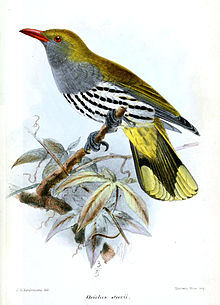Philippine oriole
| Philippine oriole | |
|---|---|

| |
| Scientific classification | |
| Domain: | Eukaryota |
| Kingdom: | Animalia |
| Phylum: | Chordata |
| Class: | Aves |
| Order: | Passeriformes |
| Family: | Oriolidae |
| Genus: | Oriolus |
| Species: | O. steerii
|
| Binomial name | |
| Oriolus steerii Sharpe, 1877
| |
| Synonyms | |
The Philippine oriole (Oriolus steerii) or grey-throated oriole is a species of bird in the family Oriolidae. It is endemic to the Philippine found on Mindanao and most of the Visayan Islands.
Its natural habitat is tropical moist lowland forests. The species is fairly common throughout its range, but the Cebu race (O. s. assimilis) was last sighted in 1906 and is now classified as extinct.

Description and taxonomy
[edit]EBird describes the bird as "Medium-sized brownish swiftlet with a weakly forked tail. Found only in the Philippine lowlands. Typically encountered alone or in loose groups over various open habitats, often soaring high. Fairly uniform brown plumage, lack of a pale rump, and size distinguish this species from most others in the area; Philippine Swiftlet is the most similar but is smaller, has a more square-tipped tail, and generally favors higher elevations (typically 700 meters and above)."
First described by Richard Bowdler Sharpe in 1877, the Philippine oriole is a member of the genus Oriolus. Some authorities have considered it to be conspecific with, or as a subspecies of, the dark-throated oriole.[3] These two species may form a superspecies with the Isabela oriole.[4]
Subspecies
[edit]Five subspecies are recognized:[5]
- O. s. samarensis - Steere, 1890: Found on Samar, Leyte, Bohol and eastern Mindanao
- †Cebu dark-throated oriole (O. s. assimilis) - Tweeddale, 1878: Originally described as a separate species. Formerly found on Cebu
- O. s. steerii - Sharpe, 1877: Found on Masbate and Negros
- O. s. basilanicus - Ogilvie-Grant, 1896: Found on Basilan and western Mindanao
- O. s. cinereogenys - Bourns & Worcester, 1894: Found in the Sulu Archipelago
Ecology and behavior
[edit]Its diet has not yet been recorded but it is presumed to feed on insects, fruits, nectar and berries. Occurs singly, in small groups or with mixed-species flocks of other medium sized birds like Bar-bellied cuckooshrike, Black-bibbed cicadabird and Philippine leafbird.
There is no information about its breeding habits and nesting.[6]
Habitat and conservation status
[edit]This species habitat is primary and secondary forest up to 1,200 meters above sea level.
IUCN has assessed this bird as least-concern species with the population believed to be stable. However, deforestation in the Philippines continues throughout the country due to slash and burn farming, mining, illegal logging and habitat conversion. This species is still trapped for the pet trade.
It is found in multiple protected areas such as Pasonanca Natural Park, Rajah Sikatuna Protected Landscape, Northern Negros Natural Park and Samar Island Natural Park but like all areas in the Philippines, protection is lax and deforestation continues despite this protection on paper. [7]
References
[edit]- ^ BirdLife International (2016). "Oriolus steerii". IUCN Red List of Threatened Species. 2016: e.T22706372A94066348. doi:10.2305/IUCN.UK.2016-3.RLTS.T22706372A94066348.en. Retrieved 17 November 2021.
- ^ a b Arthur, Marquis of Tweedale (1877). "Contribution to the Ornithology of the Philippines, No. II". Proceedings of the Scientific Meetings of the Zoological Society of London for the Year 1877. London, England: Zoological Society of London. p. 760.
- ^ Sibley, Charles Gald; Monroe, Burt Leavelle (1990). Distribution and Taxonomy of Birds of the World. New Haven, CT, USA: Yale University Press. p. 478. ISBN 978-0-300-04969-5.
- ^ "Dark-throated Oriole (Oriolus xanthonotus)". www.hbw.com. Retrieved 2017-02-24.
- ^ "IOC World Bird List 7.1". IOC World Bird List Datasets. doi:10.14344/ioc.ml.7.1.
- ^ Walther, Bruno; Jones, Peter; Kirwan, Guy M. (2020). "Philippine Oriole (Oriolus steerii), version 1.0". Birds of the World. doi:10.2173/bow.phiori1.01species_shared.bow.project_name. ISSN 2771-3105.
- ^ IUCN (2016-10-01). Oriolus steerii: BirdLife International: The IUCN Red List of Threatened Species 2016: e.T22706372A94066348 (Report). International Union for Conservation of Nature. doi:10.2305/iucn.uk.2016-3.rlts.t22706372a94066348.en.

